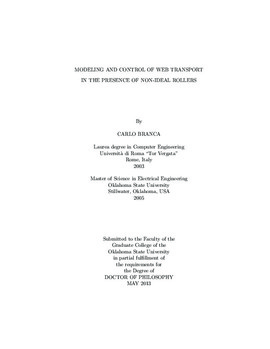| dc.contributor.advisor | Pagilla, Prabhakar R. | |
| dc.contributor.author | Branca, Carlo | |
| dc.date.accessioned | 2014-09-24T14:16:27Z | |
| dc.date.available | 2014-09-24T14:16:27Z | |
| dc.date.issued | 2013-05 | |
| dc.identifier.uri | https://hdl.handle.net/11244/10959 | |
| dc.description.abstract | In roll-to-roll processes the presence of non-ideal elements, such us out-of-round or eccentric rollers is fairly common. Periodic oscillations in web tension and web velocity are observed because of the presence of such non-ideal elements. Models of web transport on rollers based on the ideal behavior of various machine elements are not able to reproduce these oscillations in model simulations but can only follow the average of the measured tension and velocity signals. In order to reproduce the tension oscillations the models have to be modified to include the mechanism that creates the oscillations. The first part of this dissertation discusses the necessary modification of the governing equations of web velocity and web tension in the presence of an eccentric roller and an out-of-round roll. It was found that two aspects need to be included in the model: (i) the web span length adjacent to the non-ideal roller is varying with time and must be included in the governing equation for web span tension and (ii) the material flow rate in the web span, which is needed for deriving the governing equation for web tension, is not proportional to the peripheral velocity of the roller as in the ideal case and must be explicitly computed. An extensive set of experiments is presented to validate the proposed governing equations for web transport. The second part of the dissertation addresses the problem of designing a control algorithm for the attenuation of oscillations in the presence of a non-ideal roller. Besides stability, the controller needs to guarantee robustness to changing configurations and simplicity for real time implementation. An adaptive feed-forward control algorithm is identified as a suitable control algorithm for the attenuation of tension and velocity oscillations. The algorithm estimates amplitude and phase of the oscillations and generates a control input which compensates for the oscillations. Extensive experiments are conducted on a large web platform with different scenarios and by transporting two different web materials at various speeds. Experimental results show the effectiveness of the proposed algorithm to attenuate tension and velocity oscillations due to non-ideal rollers. | |
| dc.format | application/pdf | |
| dc.language | en_US | |
| dc.rights | Copyright is held by the author who has granted the Oklahoma State University Library the non-exclusive right to share this material in its institutional repository. Contact Digital Library Services at lib-dls@okstate.edu or 405-744-9161 for the permission policy on the use, reproduction or distribution of this material. | |
| dc.title | Modeling and control of web transport in the presence of non-ideal rollers | |
| dc.contributor.committeeMember | Reid, Karl N. | |
| dc.contributor.committeeMember | Young, Gary E. | |
| dc.contributor.committeeMember | Hagan, Martin T. | |
| osu.filename | Branca_okstate_0664D_12760.pdf | |
| osu.accesstype | Open Access | |
| dc.type.genre | Dissertation | |
| dc.type.material | Text | |
| thesis.degree.discipline | Mechanical Engineering | |
| thesis.degree.grantor | Oklahoma State University | |
